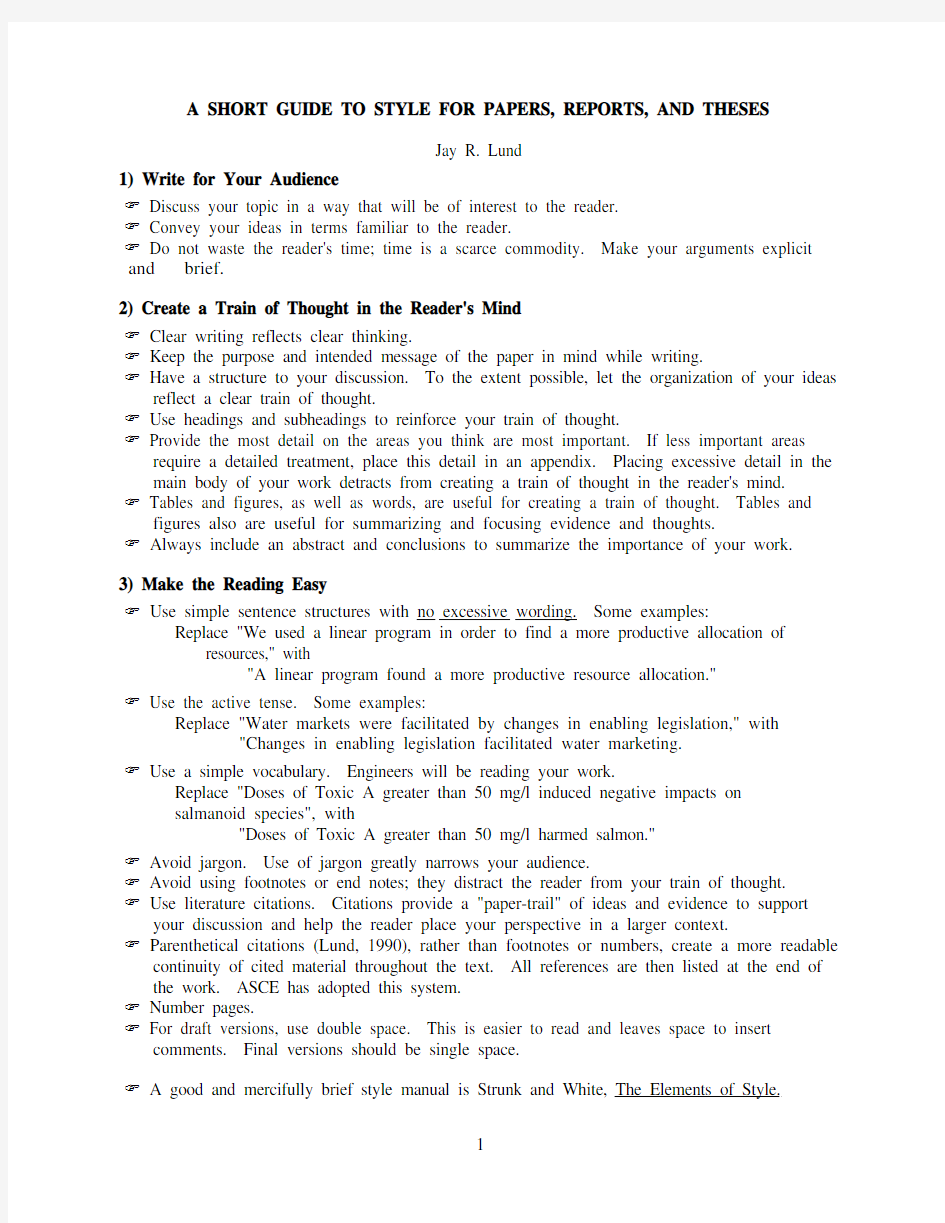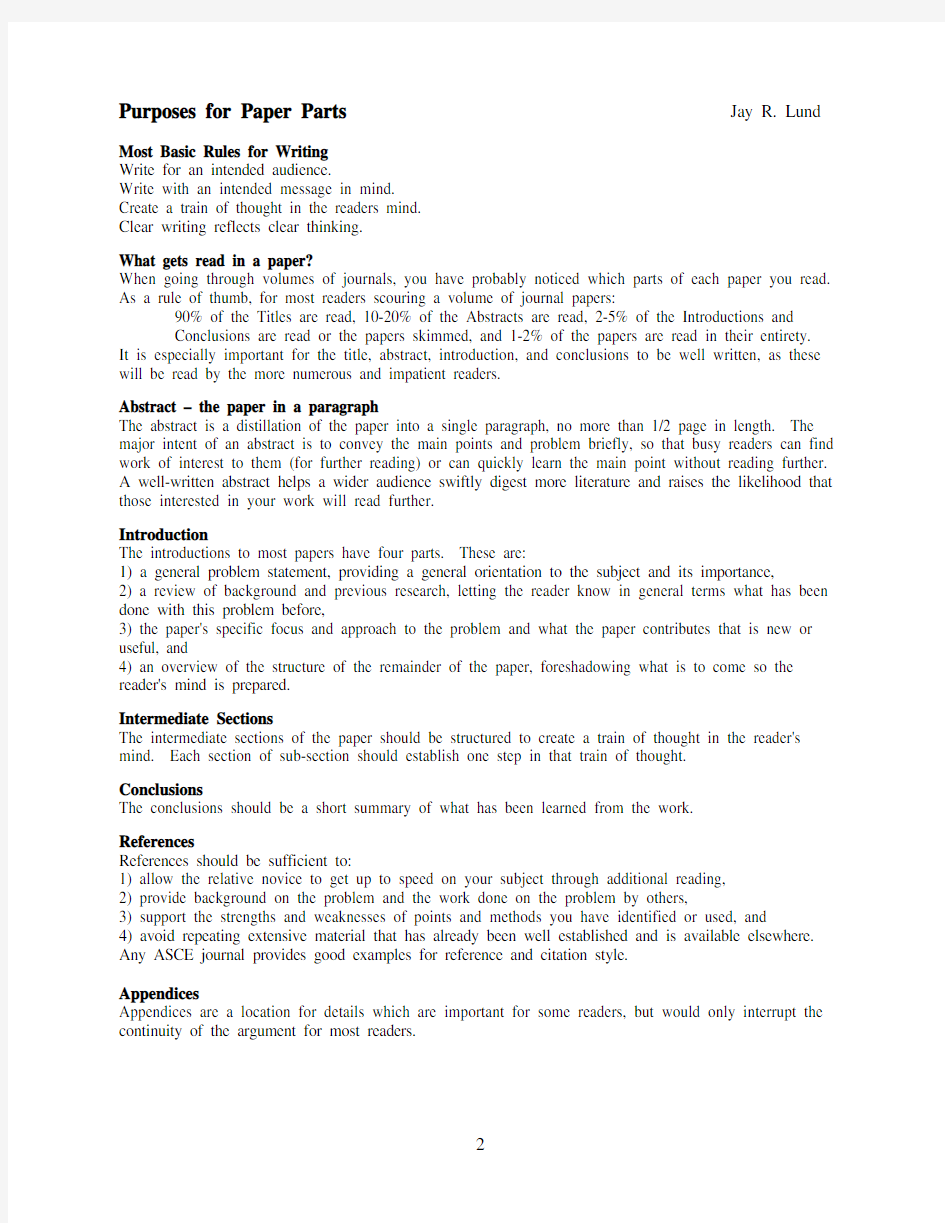

A SHORT GUIDE TO STYLE FOR PAPERS, REPORTS, AND THESES
Jay R. Lund
1) Write for Your Audience
) Discuss your topic in a way that will be of interest to the reader.
) Convey your ideas in terms familiar to the reader.
) Do not waste the reader's time; time is a scarce commodity. Make your arguments explicit brief.
and
2) Create a Train of Thought in the Reader's Mind
) Clear writing reflects clear thinking.
) Keep the purpose and intended message of the paper in mind while writing.
) Have a structure to your discussion. To the extent possible, let the organization of your ideas reflect a clear train of thought.
) Use headings and subheadings to reinforce your train of thought.
) Provide the most detail on the areas you think are most important. If less important areas require a detailed treatment, place this detail in an appendix. Placing excessive detail in the main body of your work detracts from creating a train of thought in the reader's mind.
) Tables and figures, as well as words, are useful for creating a train of thought. Tables and figures also are useful for summarizing and focusing evidence and thoughts.
) Always include an abstract and conclusions to summarize the importance of your work.
3) Make the Reading Easy
) Use simple sentence structures with no excessive wording. Some examples:
Replace "We used a linear program in order to find a more productive allocation of
resources," with
"A linear program found a more productive resource allocation."
) Use the active tense. Some examples:
Replace "Water markets were facilitated by changes in enabling legislation," with "Changes in enabling legislation facilitated water marketing.
) Use a simple vocabulary. Engineers will be reading your work.
Replace "Doses of Toxic A greater than 50 mg/l induced negative impacts on
salmanoid species", with
"Doses of Toxic A greater than 50 mg/l harmed salmon."
) Avoid jargon. Use of jargon greatly narrows your audience.
) Avoid using footnotes or end notes; they distract the reader from your train of thought.
) Use literature citations. Citations provide a "paper-trail" of ideas and evidence to support your discussion and help the reader place your perspective in a larger context.
) Parenthetical citations (Lund, 1990), rather than footnotes or numbers, create a more readable continuity of cited material throughout the text. All references are then listed at the end of the work. ASCE has adopted this system.
) Number pages.
) For draft versions, use double space. This is easier to read and leaves space to insert comments. Final versions should be single space.
) A good and mercifully brief style manual is Strunk and White, The Elements of Style.
Purposes for Paper Parts Jay R. Lund Most Basic Rules for Writing
Write for an intended audience.
Write with an intended message in mind.
Create a train of thought in the readers mind.
Clear writing reflects clear thinking.
What gets read in a paper?
When going through volumes of journals, you have probably noticed which parts of each paper you read. As a rule of thumb, for most readers scouring a volume of journal papers:
90% of the Titles are read, 10-20% of the Abstracts are read, 2-5% of the Introductions and
Conclusions are read or the papers skimmed, and 1-2% of the papers are read in their entirety.
It is especially important for the title, abstract, introduction, and conclusions to be well written, as these will be read by the more numerous and impatient readers.
Abstract – the paper in a paragraph
The abstract is a distillation of the paper into a single paragraph, no more than 1/2 page in length. The major intent of an abstract is to convey the main points and problem briefly, so that busy readers can find work of interest to them (for further reading) or can quickly learn the main point without reading further.
A well-written abstract helps a wider audience swiftly digest more literature and raises the likelihood that those interested in your work will read further.
Introduction
The introductions to most papers have four parts. These are:
1) a general problem statement, providing a general orientation to the subject and its importance,
2) a review of background and previous research, letting the reader know in general terms what has been done with this problem before,
3) the paper's specific focus and approach to the problem and what the paper contributes that is new or useful, and
4) an overview of the structure of the remainder of the paper, foreshadowing what is to come so the reader's mind is prepared.
Intermediate Sections
The intermediate sections of the paper should be structured to create a train of thought in the reader's mind. Each section of sub-section should establish one step in that train of thought.
Conclusions
The conclusions should be a short summary of what has been learned from the work.
References
References should be sufficient to:
1) allow the relative novice to get up to speed on your subject through additional reading,
2) provide background on the problem and the work done on the problem by others,
3) support the strengths and weaknesses of points and methods you have identified or used, and
4) avoid repeating extensive material that has already been well established and is available elsewhere. Any ASCE journal provides good examples for reference and citation style.
Appendices
Appendices are a location for details which are important for some readers, but would only interrupt the continuity of the argument for most readers.